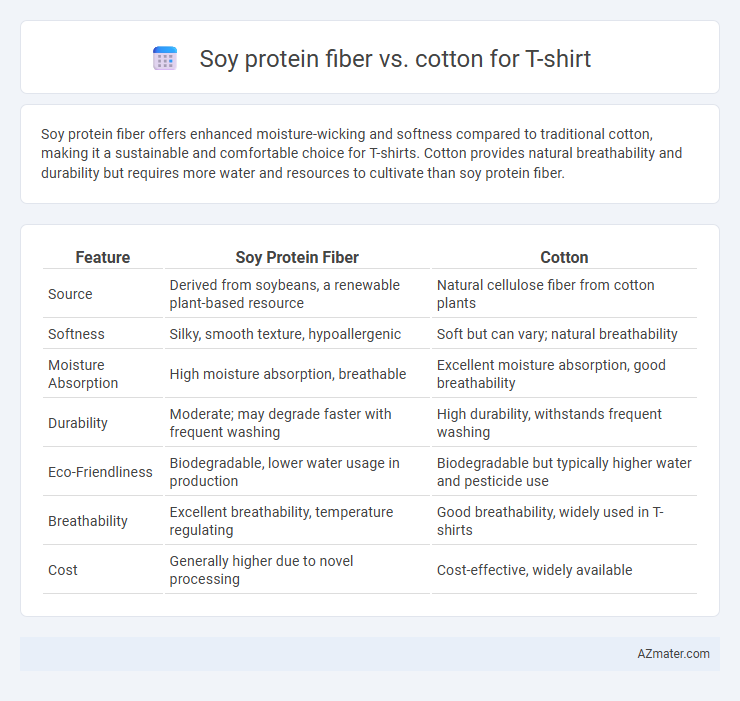Soy protein fiber offers enhanced moisture-wicking and softness compared to traditional cotton, making it a sustainable and comfortable choice for T-shirts. Cotton provides natural breathability and durability but requires more water and resources to cultivate than soy protein fiber.
Table of Comparison
| Feature | Soy Protein Fiber | Cotton |
|---|---|---|
| Source | Derived from soybeans, a renewable plant-based resource | Natural cellulose fiber from cotton plants |
| Softness | Silky, smooth texture, hypoallergenic | Soft but can vary; natural breathability |
| Moisture Absorption | High moisture absorption, breathable | Excellent moisture absorption, good breathability |
| Durability | Moderate; may degrade faster with frequent washing | High durability, withstands frequent washing |
| Eco-Friendliness | Biodegradable, lower water usage in production | Biodegradable but typically higher water and pesticide use |
| Breathability | Excellent breathability, temperature regulating | Good breathability, widely used in T-shirts |
| Cost | Generally higher due to novel processing | Cost-effective, widely available |
Introduction to Soy Protein Fiber and Cotton T-Shirts
Soy protein fiber, derived from natural soybean residues, offers a sustainable and biodegradable alternative to traditional cotton fiber in T-shirt production. Cotton, known for its breathability and softness, remains a top choice but requires significant water and pesticide use, impacting environmental sustainability. Comparing soy protein fiber to cotton highlights benefits in moisture absorption, antibacterial properties, and eco-friendliness ideal for comfortable and eco-conscious T-shirt manufacturing.
Origins and Production Processes
Soy protein fiber originates from leftover soybean curd after tofu production, where the soy protein is extracted, processed into a viscous liquid, and then spun into fibers using wet spinning techniques. Cotton fibers are harvested from the seed hairs of the cotton plant, undergoing ginning to separate fibers from seeds, followed by carding and spinning into yarn. The production of soy protein fiber is more chemically intensive and dependent on food industry byproducts, whereas cotton cultivation relies heavily on agricultural inputs like water and pesticides.
Environmental Impact: Sustainability Comparison
Soy protein fiber, derived from renewable soybeans, offers a more sustainable alternative to conventional cotton by requiring less water and fewer pesticides during cultivation. Cotton farming consumes approximately 10,000 liters of water per kilogram, whereas soy protein fiber production significantly reduces water usage and chemical input. This lower environmental footprint makes soy protein fiber an eco-friendly choice for T-shirts, aligning with sustainable fashion goals and reducing overall resource depletion.
Comfort and Softness: Fabric Feel Analysis
Soy protein fiber offers exceptional softness and a smooth texture, making it highly comfortable against the skin, often compared to natural silk. Cotton boasts breathable properties and a soft feel but can sometimes be coarser depending on the weave and quality. The moisture-wicking ability of soy protein fiber enhances comfort by keeping the skin dry, whereas cotton excels in absorbency but may feel heavier when wet.
Moisture Absorption and Breathability
Soy protein fiber offers superior moisture absorption compared to cotton, efficiently wicking sweat away from the skin to keep the wearer dry and comfortable. Its breathable structure promotes enhanced air circulation, reducing heat retention during physical activities. Cotton, while naturally breathable and soft, tends to retain moisture longer, which can cause a damp feeling in high-humidity conditions.
Durability and Longevity
Soy protein fiber exhibits impressive durability due to its high tensile strength and resistance to wear, making it a sustainable alternative to cotton in T-shirt manufacturing. Cotton, while traditionally popular, tends to weaken over repeated washes and prolonged exposure to sunlight, reducing its longevity compared to soy protein fiber. Garments made from soy protein fiber maintain structural integrity and color vibrancy longer, enhancing overall lifespan and value.
Allergenicity and Skin Health
Soy protein fiber offers hypoallergenic properties that reduce the risk of skin irritation compared to traditional cotton, making it ideal for sensitive skin. It contains natural proteins that enhance moisture retention and promote skin smoothness, unlike cotton which may cause dryness in some users. Cotton remains breathable but can harbor allergens more easily, potentially exacerbating skin conditions like eczema.
Price Point and Market Availability
Soy protein fiber T-shirts typically come at a higher price point than cotton due to their eco-friendly properties and the complexity of production. Cotton remains widely available and more affordable, dominating the market with extensive production infrastructure. The growing demand for sustainable fabrics is gradually increasing the market availability of soy protein fiber, though it still represents a niche segment compared to the mass-market cotton T-shirts.
Style Versatility and Dyeing Properties
Soy protein fiber offers superior dye absorption and vibrant color retention compared to cotton, enabling more diverse and intense color options for T-shirts. Its smooth texture enhances the fabric's ability to hold intricate prints and patterns, increasing style versatility for contemporary fashion designs. Cotton, while versatile and breathable, tends to fade faster and has limited dye affinity, which can restrict long-term color vibrancy and pattern sharpness.
Future Prospects in Sustainable Fashion
Soy protein fiber offers a promising alternative to cotton in sustainable fashion due to its biodegradability, lower water usage, and renewable source derived from okara, a soybean byproduct. Innovations in soy protein fiber enhance fabric softness and durability, positioning it as a viable material for eco-friendly T-shirts that reduce environmental impact compared to traditional cotton cultivation. As consumer demand for sustainable textiles grows, soy protein fiber's integration into fashion supply chains can drive circular economy practices and lessen reliance on resource-intensive cotton farming.

Infographic: Soy protein fiber vs Cotton for T-shirt
 azmater.com
azmater.com